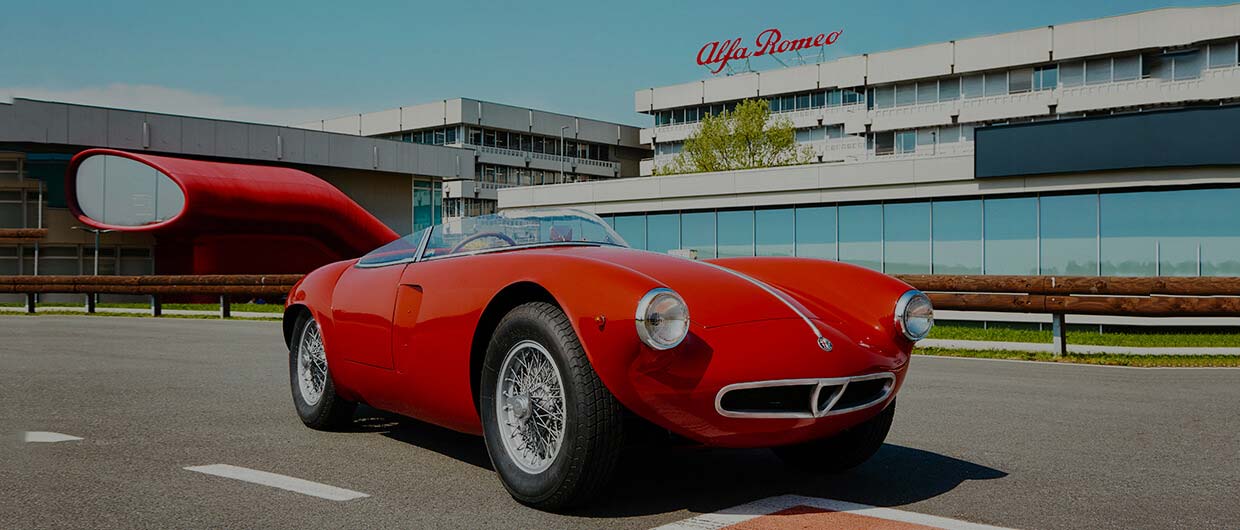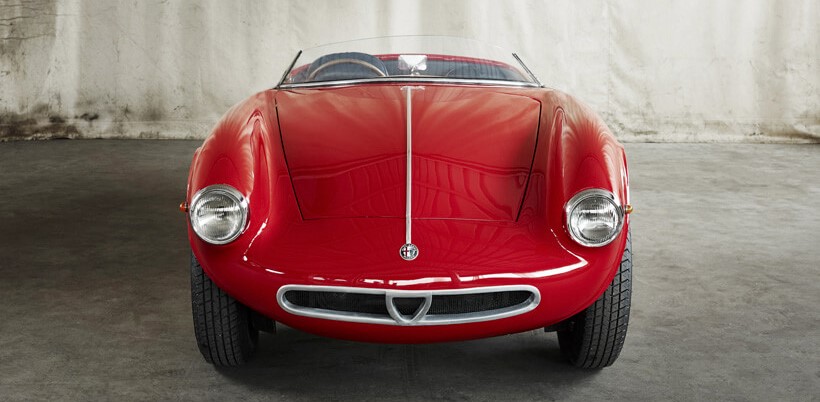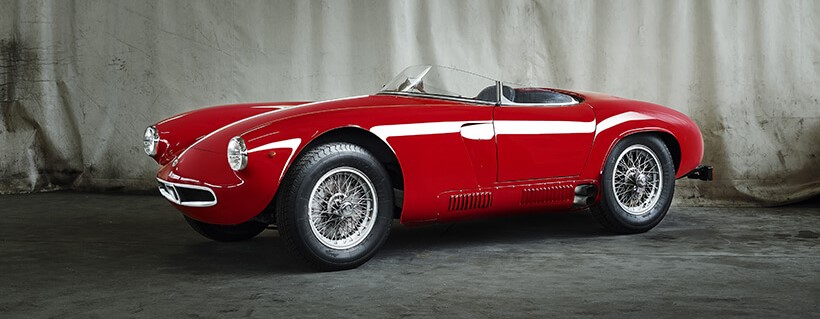
1900 Sport Spider (1954)
A very rare racing spider – only 2 models of which were ever produced – fitted with a 4-cylinder twin-cam engine, supercharged to 138 hp of peak output, enabling it to reach 220 km/h, partly down to its weight of 880 kg and its greatly efficient aerodynamics. Featuring Franco Scaglione’s innovative design for the Bertone workshop, the 1900 Sport Spider is fitted with 5-speed transmission and a De Dion rear axle: its performance and driveability are that of a more recent, responsive and earnest car, with great road grip. This extraordinary car will compete under number “289”.
1900 Super Sprint (1956)
Competing in the race under number “392” will be the enchanting 1900 Super Sprint (1956), 1900 Super Sprint (1956), an elegant coupé that represents the “gran turismo” class of the 20th century, “the family car that wins races” in the words of the claim that made its fame in the 1950s. Based on the short version chassis of the 1900 sedan, it is fitted with a 2-liter 4-cylinder engine with the brand’s characteristic twin camshaft and an output of 115 hp at 5500 rpm. In the 1950s, it was customary for the great Italian designers to buy a mechanized chassis from Alfa Romeo, complementing it with bodywork designed and produced in-house. The Milan Touring workshop therefore did so, producing 858 models of this final series of the 1900 Sprint between 1955 and ’58.



The innovative Alfa Romeo 1900, produced during the 1950s, was used as a platform for the creation of high-performance racing prototypes. After the 1952 Disco Volante (Flying Saucer), bodied by Touring, Alfa Romeo entrusted the “2000 Sportiva” project to another coachbuilder and design studio, Bertone. In 1954 Bertone penned a Coupé and a Spider that were as deftly sculpted as they were fast.
Alfa Romeo won the first two Formula One World Championships during the post-war reconstruction period, but decided to concentrate all its resources into building production cars, thereby exiting the fledgling F1 championship with an unbeaten record. This pivotal change at the Portello plant notably resulted in the “1900”, which was the marque’s first car built entirely on a production line and the first Alfa with a load-bearing body integrated with the chassis.
Alfa Romeos were soon celebrated and coveted as luxury cars with a sporty dimension. To meet demand from gentleman racers, the “Biscione” brand built a number of exclusive competition variants alongside its series-produced saloons and employed renowned Italian coachbuilders—Zagato, Pininfarina, Touring, Bertone and Boano—to design vehicles that were also suitable for racing.
Aeronautic advances made during the war gave the designers a better understanding of how aerodynamics played a fundamental role in improving a car’s performance, in addition to engine power and a lightweight body.
The already sophisticated four-cylinder engine of the Alfa Romeo 1900 was tuned up to 138 hp. This power increase, combined with a weight of just 880 kg, allowed the prototype 1900 Sport Spider to reach a top speed of 220 km/h.
The “Millenove” (Italian for “1900”) was the first Alfa car with a load-bearing body, but racing models were given a lightweight yet robust tubular trellis frame covered with aerodynamically-shaped body panels. The 1997 cc twin-cam engine, equipped with two twin-barrel carburettors and a forced lubrication system, developed 138 hp at 6500 rpm. The car had a five-speed manual transmission with central lever control and rear-wheel drive, as well as independent front suspension and solid De Dion rear axle suspension with a Watt’s parallelogram linkage.
Alfa Romeo commissioned the Bertone design studio to develop two sports cars, a spider and a coupé. The Turin-based coachbuilder built four specimens with aluminium bodies, two of each type. The 2000 Sportiva Coupé—justifiably considered one of the most beautiful 1950s berlinettas ever produced—influenced the styling of the contemporary Giulietta Sprint, which was also penned by designer Franco Scaglione.
By contrast, the Spider was distinguished by its streamlined and tapered shape and the elegant, downward-facing radiator grille, which featured the Alfa Romeo shield and two classic side lobes. The result was a distinctive profile that was subsequently retained on many Portello-built sports cars, from the Giulia TZ Zagato to the Spiders of Pininfarina, but above all the 33 and particularly the 33 Stradale, which unsurprisingly was another Scaglione design.
The very rare Alfa Romeo 1900 Sport Spider, which belongs to the FCA Heritage collection at the Alfa Romeo Museum in Arese, has already participated in numerous retrospectives of the historic Mille Miglia, most recently in 2018, when it was driven by Coldplay bassist Guy Berryman and professional racing driver Derek Hill.

You must be logged in to post a comment.